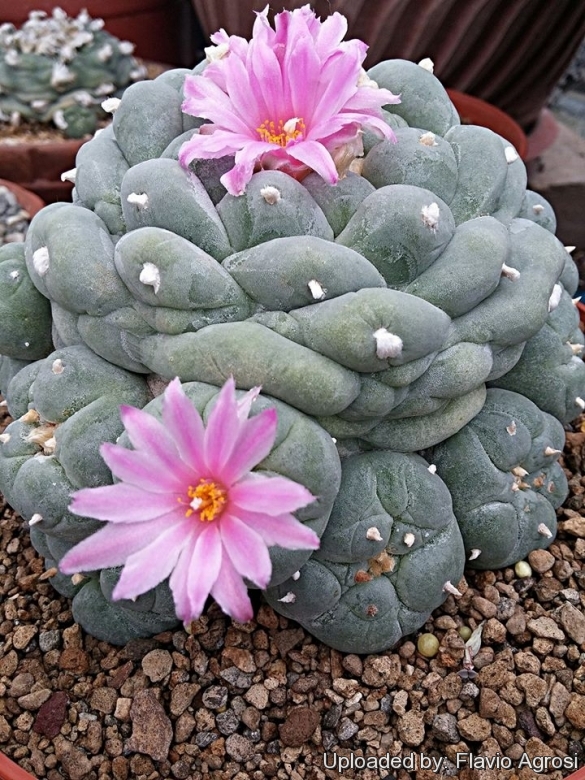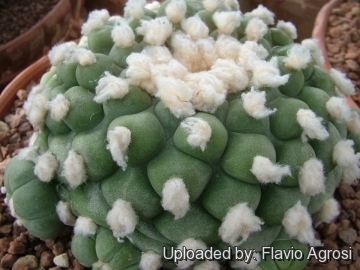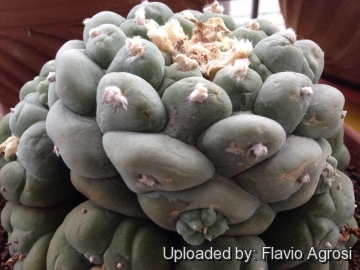Donate now to support the LLIFLE projects.
Your support is critical to our success.
Your support is critical to our success.
Accepted Scientific Name: Lophophora williamsii
Contr. U.S. Natl. Herb. 3: 131. 1894

Lophophora williamsii var. fricii cv. Marbles Photo by: Flavio Agrosi
Synonyms:
See all synonyms of Lophophora williamsii
back
Accepted name in llifle Database:Lophophora williamsii (Lem. ex Salm-Dyck) J.M.Coult.
Contr. U.S. Natl. Herb. 3: 131. 1894
Synonymy: 34
- Lophophora williamsii (Lem. ex Salm-Dyck) J.M.Coult.
- Anhalonium visnagra K.Schum.
- Anhalonium williamsii (Salm-Dyck) Rümpler
- Anhalonium williamsii Lem. ex Förster
- Ariocarpus williamsii (Salm-Dyck) Voss
- Echinocactus lewinii (Henn. ex Lewin) K.Schum. in Engl. & Prantl
- Echinocactus williamsii Lem. ex Salm-Dyck
- Echinocactus williamsii var. anhaloninicus K.Schum.
- Echinocactus williamsii var. pellotinicus (K.Schum.) Rouhier
- Mammillaria williamsii (Lem.) J.M.Coult.
- Lophophora williamsii var. echinata (Croizat) Bravo
- Lophophora echinata Croizat
- Lophophora williamsii var. fricii f. cristata hort.
- Lophophora williamsii var. fricii f. variegata hort.
- Lophophora williamsii subs. grymi Halda, J.Kupčák & Sladk.
- Lophophora williamsii var. heptagona Y.Itô
- Lophophora williamsii var. jourdaniana (Haberm.) hort.
- Anhalonium jourdanianum Lewin
- Echinocactus jourdanianus Rebut ex C.A.Maass
- Lophophora jourdaniana Haberm.
- Lophophora williamsii var. lewinii (Henn. ex Lewin) J.M.Coult.
- Anhalonium lewinii Henn. ex Lewin
- Lophophora lewinii (Henn.) Rusby
- Mammillaria lewinii (Henn. ex Lewin) H.Karst.
- Lophophora williamsii var. pentagona Croizat
- Lophophora pentagona (Croizat) V.Gapon
- Lophophora williamsii var. pluricostata Croizat
- Lophophora pluricostata (Croizat) V.Gapon
- Lophophora williamsii var. texana Frič ex Kreuz.
- Lophophora lutea var. texana (Frič ex Kreuz.) Backeb.
- Lophophora williamsii var. typica Croizat
Lophophora williamsii var. caespitosa Y.Itô
1952 (nom. inval)
Accepted name in llifle Database:
Lophophora williamsii var. caespitosa f. variegata hort.
Accepted name in llifle Database:
Lophophora williamsii var. cristata Houghton
J. Cact. Succ. Soc. Amer. 2: 490. 1931
Accepted name in llifle Database:
Lophophora williamsii var. fricii (Haberm.) Grym
Rod Lophophora 56 1997
Synonymy: 8
- Lophophora williamsii var. fricii (Haberm.) Grym
- Anhalonium floro rosea Frič
- Lophophora diffusa subs. fricii (Haberm.) Halda
- Lophophora fricii Haberm.
- Peyotl zacatensis (Haberm.) Sotom., Arred. & Mart.Mend.
- Peyotl zacatensis var. fricii (Haberm.) Sotom., Arred. & Mart.Mend.
- Lophophora fricii var. decipiens (Croizat) P.Hansen
Lophophora williamsii f. variegata hort.
Cultivars (2):
back

Lophophora williamsii var. fricii cv. Marbles Photo by: Flavio Agrosi

Lophophora williamsii var. fricii cv. Marbles Photo by: Flavio Agrosi
| Your Actions | |
|---|---|
| Back to Lophophora index | |
| Back to Cactaceae index | |
 |
Back to Cacti Encyclopedia index |








